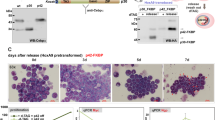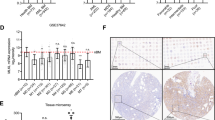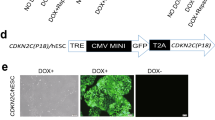Abstract
E2a/Pbx1 is a fusion oncoprotein resulting from the t(1;19) translocation found in human pre-B acute lymphocytic leukemia and in a small number of acute T-lymphoid and myeloid leukemias. It was previously suggested that E2a/Pbx1 could cooperate with normal or oncogenic signaling pathways to immortalize myeloid and lymphoid progenitor cells. To address this question, we introduced the receptor of the macrophage-colony-stimulating factor (M-CSF-R) in pro-T cells immortalized by a conditional, estradiol-dependent, E2a/Pbx1-protein, and continuously proliferating in response to stem cell factor and interleukin-7. We asked whether M-CSF-R would be functional in an early T progenitor cell and influence the fate of E2a/Pbx1-immortalized cells. E2a-Pbx1 immortalized pro-T cells could proliferate and shifted from lymphoid to myeloid lineage after signaling through exogenously expressed M-CSF-R, irrespective of the presence of estradiol. However, terminal macrophage differentiation of the cells was obtained only when estradiol was withdrawn from cultures. This demonstrated that M-CSF-R is functional for proliferation and differentiation signaling in a T-lymphoid progenitor cell, which, in addition, unveiled myeloid potential of pro-T progenitors. Moreover, the block of differentiation induced by the E2a/Pbx1 oncogene could be modulated by hematopoietic cytokines such as M-CSF, suggesting plasticity of leukemic progenitor cells. Finally, additional experiments suggested that PU.1 and eight twenty-one transcriptional regulators might be implicated in the mechanisms of oncogenesis by E2a/Pbx1.
This is a preview of subscription content, access via your institution
Access options
Subscribe to this journal
Receive 50 print issues and online access
$259.00 per year
only $5.18 per issue
Buy this article
- Purchase on Springer Link
- Instant access to full article PDF
Prices may be subject to local taxes which are calculated during checkout







Similar content being viewed by others
References
Arnaud S, Servet-Delprat C, Jurdic P, Nataf S, Grasset MF, Soulas C et al. (2002). BMC Immunol 3: 15.
Bakri Y, Sarrazin S, Mayer UP, Tillmanns S, Nerlov C, Boned A et al. (2005). Blood 105: 2707–2716.
Balciunaite G, Ceredig R, Rolink AG . (2005). Blood 105: 1930–1936.
Beutler B, Hoebe K, Du X, Ulevitch RJ . (2003). J Leukocyte Biol 74: 479–485.
Borzillo GV, Sherr CJ . (1989). Mol Cell Biol 9: 3973–3981.
Bourette RP, Arnaud S, Myles GM, Blanchet J-P, Rohrschneider LR, Mouchiroud G . (1998). EMBO J 17: 7273–7281.
Bourette RP, Myles GM, Carlberg K, Chen AR, Rohrschneider LR . (1995). Cell Growth Differ 6: 631–645.
Bourette RP, Rohrschneider LR . (2000). Growth Factors 17: 155–166.
Bourgin C, Bourette RP, Mouchiroud G, Arnaud S . (2000). FEBS Lett 480: 113–117.
Calabi F, Pannell R, Pavloska G . (2001). Mol Cell Biol 21: 5658–5666.
Carnicer MJ, Nomdedeu JF, Lasa A, Estivill C, Brunet S, Aventin A et al. (2004). Leukemia Res 28: 19–23.
Carroll AJ, Crist WM, Parmley RT, Roper M, Cooper MD, Finley WH . (1984). Blood 63: 721–724.
Chen D, Zhang G . (2001). Exp Hematol 29: 971–980.
Cheng GY, Minden MD, Toyonaga B, Mak TW, McCulloch EA . (1986). J Exp Med 163: 414–424.
Chevallier N, Corcoran CM, Lennon C, Hyjek E, Chadburn A, Bardwell VJ et al. (2004). Blood 103: 1454–1463.
Dai XM, Ryan GR, Hapel AJ, Dominguez MG, Russell RG, Kapp S et al. (2002). Blood 99: 111–120.
Dakic A, Metcalf D, Di Rago L, Mifsud S, Wu L, Nutt SL . (2005). J Exp Med 201: 1487–1502.
Davis JN, McGhee L, Meyers S . (2003). Gene 303: 1–10.
DeKoter RP, Walsh JC, Singh H . (1998). EMBO J 17: 4456–4468.
Du Y, Campbell JL, Nalbant D, Youn H, Bass ACH, Cobos E et al. (2002). Exp Hematol 30: 649–658.
Duval D, Reinhardt B, Kedinger C, Bœuf H . (2000). FASEB J 14: 1577–1584.
Erickson PF, Dessev G, Lasher RS, Philips G, Robinson M, Drabkin HA . (1996). Blood 88: 1813–1823.
Follows GA, Tagoh H, Richards SJ, Melnik S, Dickinson H, de Wynter E et al. (2005). Oncogene 24: 3643–3651.
Fukuyama T, Sueoka E, Sugio Y, Otsuka T, Niho Y, Akagi K et al. (2001). Oncogene 20: 6225–6232.
Gilliland DG, Jordan CT, Felix CA . (2004). Hematology (Am Soc Hematol Educ Program), 80–97.
Gobert Gosse S, Bourgin C, Liu WQ, Garbay C, Mouchiroud G . (2005). Cell Signal 17: 1352–1362.
Hoffbrand AV, Leber BF, Browett PJ, Norton JD . (1988). Blood Rev 2: 9–15.
Ibañez V, Sharma A, Buonamici S, Verma A, Kalakonda S, Wang J et al. (2004). Cancer Res 64: 4547–4554.
Iwasaki-Arai J, Iwasaki H, Miyamoto T, Watanabe S, Akashi K . (2003). J Exp Med 197: 1311–1322.
Kamps MP, Baltimore D . (1993). Mol Cell Biol 13: 351–357.
Kamps MP, Wright DD . (1994). Oncogene 9: 3159–3166.
Katsura Y . (2002). Nat Rev Immunol 2: 127–132.
Kelly LM, Englmeier U, Lafon I, Sieweke MH, Graf T . (2000). EMBO J 19: 1987–1997.
King AG, Kondo M, Scherer DC, Weissman IL . (2002). Proc Natl Acad Sci USA 99: 4508–4513.
Kitamura T, Koshino Y, Shibata F, Oki T, Nakajima H, Nosaka T et al. (2003). Exp Hematol 31: 1007–1014.
Kondo M, Scherer DC, Miyamoto T, King AG, Akashi K, Sugamura K et al. (2000). Nature 407: 383–386.
Krause DS . (2002). Oncogene 21: 3262–3269.
Lacaud G, Gore L, Kennedy M, Kouskoff V, Kingsley P, Hogan C et al. (2002). Blood 100: 458–466.
Lee C-K, Kim JK, Kim Y, Lee M-K, Kim K, Kang J-K et al. (2001). J Immunol 166: 5964–5969.
Lindberg SR, Olson A, Persson A-M, Olsson I . (2005). Exp Hematol 33: 189–198.
Lodie TA, Savedra R, Golenbock DT, Van Beveren CP, Maki RA, Fenton MJ . (1997). J Immunol 158: 1848–1856.
Lord KA, Abdollahi A, Hoffmann-Liebermann B, Libermann DA . (1993). Mol Cell Biol 13: 841–851.
Mancini A, Koch A, Whetton AD, Tamura T . (2004). Oncogene 23: 6581–6589.
Matsuoka T, Zhao L, Artner I, Jarrett HW, Friedman D, Means A et al. (2003). Mol Cell Biol 23: 6049–6062.
Metcalf D . (1998). Blood 92: 345–348.
Nutt SL, Metcalf D, D'Amico A, Polli M, Wu L . (2005). J Exp Med 201: 221–231.
Pawlak G, Grasset MF, Arnaud S, Blanchet J-P, Mouchiroud G . (2000). Exp Hematol 28: 1164–1173.
Rochford JJ, Semple RK, Laudes M, Boyle KB, Christodoulides C, Mulligan C et al. (2004). Mol Cell Biol 24: 9863–9872.
Rohrschneider LR, Metcalf D . (1989). Mol Cell Biol 9: 5081–5092.
Sasmono RT, Oceandy D, Pollard JW, Tong W, Pavli P, Wainwright BJ et al. (2003). Blood 101: 1155–1163.
Scheijen B, Griffin JD . (2002). Oncogene 21: 3314–3333.
Stanley ER, Berg KL, Einstein DB, Lee PS, Yeung YG . (1994). Stem Cells 12: 15–24.
Stirewalt DL, Radich JP . (2003). Nat Rev Cancer 3: 650–665.
Sykes DB, Kamps MP . (2001). Blood 98: 2308–2318.
Sykes DB, Kamps MP . (2004). Mol Cell Biol 24: 1256–1269.
Sykes DB, Scheele J, Pasillas M, Kamps MP . (2003). Leukemia Lymphoma 44: 1187–1199.
Tagoh H, Himes R, Clarke D, Leenen PJM, Riggs AD, Hume D et al. (2002). Genes Dev 16: 1721–1737.
Tamura T, Mancini A, Joos H, Koch A, Hakim C, Dumanski J et al. (1999). Oncogene 18: 6488–6495.
Torrès H, Dubreuil P, Falzetti F, Courcoul MA, Lopez M, Falcinetti F et al. (1990). Leukemia 4: 673–677.
Troussard X, Rimokh R, Valensi F, Leboeuf D, Fenneteau O, Guitard AM et al. (1995). Br J Haematol 89: 516–526.
Zheng R, Klang K, Gorin NC, Small D . (2004a). Leukemia Res 28: 121–126.
Zheng R, Levis M, Piloto O, Brown P, Baldwin BR, Gorin NC et al. (2004b). Blood 103: 267–274.
Zhu J, Emerson SG . (2002). Oncogene 21: 3295–3313.
Acknowledgements
We are grateful to Dr David A Hume for the gift of the transgene delta6.7fms-EGFP. We have greatly appreciated the generosity of Dr Mark P Kamps for E2a/Pbx1b constructs and for helpfull discussion. We thank Dr Kitamura for the gift of pMX-IG vector and PlatE cells, S Sarrazin and M Sieweke for the gift of MFG-PUER-EGFP construct and Dr Moreau-Gachelin for the gift of anti-PU.1 antibody. We also thank lab members for stimulating discussions, and to Michele Weiss for her help with cell sorting. This work was supported by grants from the Ligue Nationale contre le Cancer (Labellisations 2000 and 2004) and from the Centre National de la Recherche Scientifique.
Author information
Authors and Affiliations
Corresponding author
Rights and permissions
About this article
Cite this article
Bourette, R., Grasset, MF. & Mouchiroud, G. E2a/Pbx1 oncogene inhibits terminal differentiation but not myeloid potential of pro-T cells. Oncogene 26, 234–247 (2007). https://doi.org/10.1038/sj.onc.1209777
Received:
Revised:
Accepted:
Published:
Issue Date:
DOI: https://doi.org/10.1038/sj.onc.1209777
Keywords
This article is cited by
-
PBX1: a key character of the hallmarks of cancer
Journal of Molecular Medicine (2021)
-
Src-family kinases play an essential role in differentiation signaling downstream of macrophage colony-stimulating factor receptors mediating persistent phosphorylation of phospholipase C-γ2 and MAP kinases ERK1 and ERK2
Leukemia (2008)



